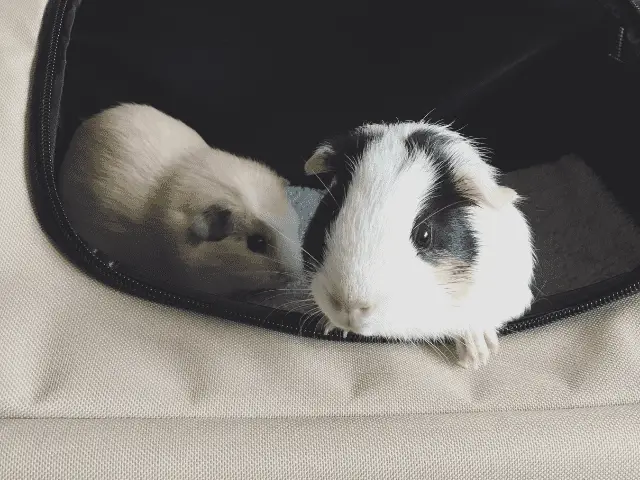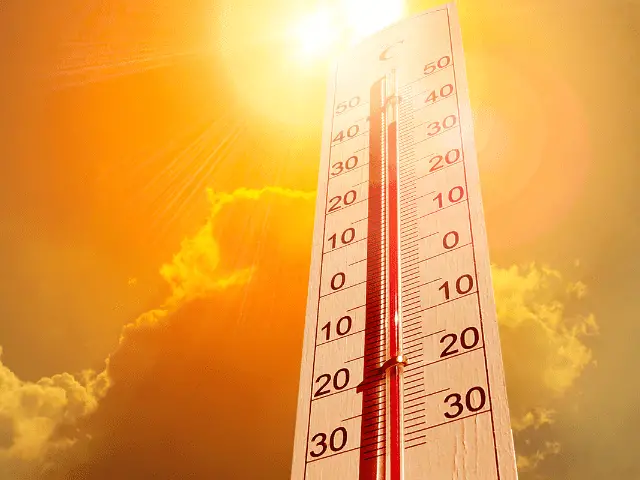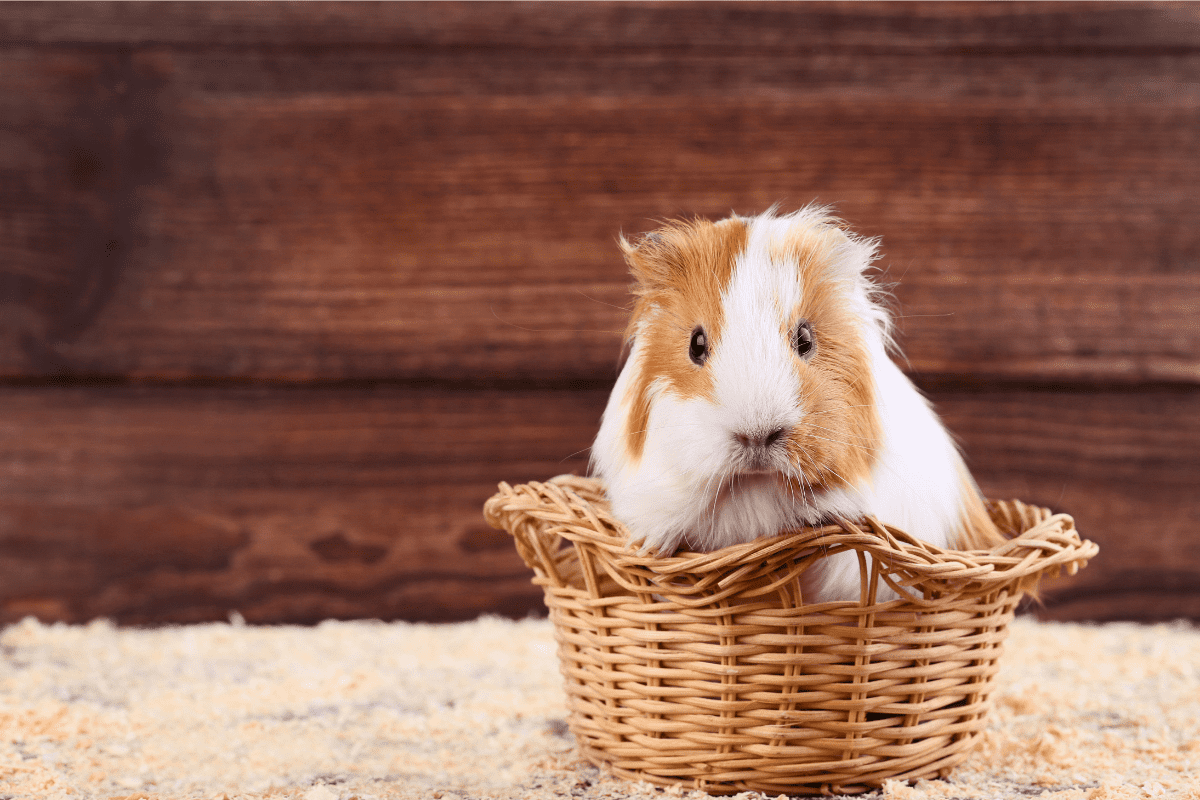Whether you’re moving homes, visiting family across the country, or taking your guinea pigs to the vet, there comes a time when you need to move your pet from one place to another.
Moving with a guinea pig is less stressful than moving with a cat or a dog, but still comes with it’s share of challenges.
When transporting guinea pigs, you don’t have to worry about potty breaks, loud vocal protests, or destructive behaviors while on the go like with other animals. Still, it’s your responsibility to mitigate the anxiety of the situation as much as possible—and I’m here to help you with just that.
In this article, I’ve shared my top 7 tips on how to move with a guinea pig. Let’s dive right in!
Table of Contents
1. Get a Suitable Pet-Carrier

Your guinea pigs are going to spend a good amount of their time in a pet carrier when moving, so you’ll want to make sure it’s as comfortable as possible.
Make sure your guinea pig carrier is spacious enough for your guinea pig to stand up, lie down, and change positions during travel. It should have soft sides so your piggies won’t get hurt during transport.
The interior should be dark and well ventilated so it’s less stressful for piggies. For increased comfort, line the carrier with a soft towel or a fleece blanket.
Don’t have a pet carrier? Use a cardboard box instead to make your own guinea pig cage. Of course, you can’t move your guinea pig across the country in a flimsy cardboard box, so it’s suitable for short journeys only.
Tape the sides of the box with high-quality packing tape so your guinea pigs won’t fall out of the bottom. Like the carrier, line the box with a soft towel or a blanket, and wrap it in a blanket just in case your guinea pigs decide to chew their way out of the box. Poke some holes on the box so they’ll get sufficient lighting and adequate airflow.
Also, the box must be tall so your guinea pig won’t Houdini themselves out of it.
It’s safe to put up to three guinea pigs inside one carrier/box, provided it has enough space for all three of them.
Guinea pigs are pack animals and thus find comfort with each other during stressful times, like moving homes or visiting the vet. Just make sure the carrier/box is big enough to house your guinea pigs comfortably.
2. Make Arrangements With the Airline
If you’re moving out of the country or even just cross country, make sure the airline you’re using allows guinea pigs in the cabin, because not a lot do.
For instance many airline companies – American Airlines, United Airlines, Delta Airlines, and Southwest Airlines all don’t allow guinea pigs on board, but rather in checked baggage.
But since guinea pigs are small and fragile, they should never travel with the plane’s luggage or cargo areas. It would be extremely stressful and your guinea pig could become sick or get injured.
So, before traveling, make arrangements with the airline in question.
Additionally, check the destination state requirements for traveling with guinea pigs, as some require extra documents (health certificate, pet passport, microchip registration, etc.).
The USDA website is a fantastic source of information, as it links to specific requirements for taking pets to another country or moving them from state to state.
is a fantastic source of information, as it links to specific requirements for taking pets to another country or moving them from state to state.
Alongside the travel documents, ensure that you’re using an appropriate travel carrier. With most airlines, the maximum dimensions allowed for soft-sided kennels are 18 inches long x 11 inches wide x 11 inches high.
3. Prepare Ahead
Always carry food supplies and a water bottle for your guinea pig, regardless of the distance of your car journey.
If you’re moving during the summer, bring along frozen bottles of water to keep your guinea pig cool.
Also, don’t overfeed your guinea pig before the move because they might get sick during travel. Instead, bring along a small bag of healthy treats like celery, carrot slices, and a few handfuls of high-quality pellets.
For longer trips, bring your guinea pig’s usual food bowl, water bottle, and litter box. Carry extra litter with you, too. Pack up their favorite toys and their exercise pens so they won’t get bored during the trip.
If your pet takes special medication, ensure you have enough on hand to last the whole trip.
4. Beware of Heat Stroke

Guinea pigs are extremely sensitive to heat . In the wild, they seek refuge in cooler temperatures. Guinea pigs don’t have sweat glands, so they can’t regulate heat by means of sweating. So, if they’re stuck in a warm car for hours, they might fall victim to the heat.
. In the wild, they seek refuge in cooler temperatures. Guinea pigs don’t have sweat glands, so they can’t regulate heat by means of sweating. So, if they’re stuck in a warm car for hours, they might fall victim to the heat.
To prevent heat stroke, make sure your car is properly ventilated—especially during the summer. Turn your car’s air conditioning system on throughout your travel.
If your car doesn’t have an air conditioner, open the windows and place an ice-cold water bottle (wrapped in a towel) in the carrier to cool them down.
On particularly warm days, put a cold, slightly damp towel around their bodies for several minutes.
Keep your piggies well hydrated, too. Let them drink from the bottle every hour or so. You can also feed them water-rich treats such as watermelon, lettuce, and apples during your trip.
Last but not least, position the carrier/box away from direct sunlight. Cover it with a towel, but make sure your piggies are getting enough fresh air and ventilation inside the box.
5. Properly Position the Carrier
The guinea pig’s carrier must be secured at all times during travel.
If you’re moving in a car, strap the carrier with a seat belt so it won’t slide and jolt around.
You can also position the carrier on the floor behind the car seat.
For short trips less than 30 minutes long, ask a family member to place the carrier on his or her lap.
Do NOT place the carrier in the trunk of the car, as it’s too dark and doesn’t have enough ventilation. It’s a scary place for a guinea pig, and you certainly don’t want them to suffocate in there!
6. Keep Your Guinea Pig Inside the Carrier

Resist the urge to take your guinea pigs out of the carrier, even if they’re clearly not happy in there. Keep them inside until you’ve arrived at your destination.
If you’re traveling with children, let them know of the dangers associated with taking a pet out of its carrier while traveling.
Open the carrier only when absolutely necessary.
The last thing you want is your guinea pigs running amok in your car and distracting you from driving. If you have to take them out, don’t let your guinea pigs run around unrestrained. Always keep them contained to prevent them from escaping.
7. Check On Your Guinea Pig Regularly
Check how your guinea pigs are doing every hour or so. If you’re traveling alone, pull over at a rest stop instead of glancing at the carrier.
Use that time to pet your guinea pigs, give them treats, and refill their food supply. It’s also the best time to make sure they’re comfortable and behaving normally.
Look for signs of distress, such as hissing, growling, whining, squealing, and chattering teeth. Find out the cause of such behavior and eliminate it.
If it’s caused by travel anxiety, make sure they’re properly fed and hydrated, and throw a thin blanket over their cage as they’re less stressed in the dark.
Bottom Line
Guinea pigs aren’t as fussy as cats or dogs, so moving them from place to place isn’t as stressful as you might initially think.
Still, it’s important to minimize their stress and anxiety when moving through proper planning. A guinea pig is fragile and small, so they can get hurt or fall ill during the move.
Avoid this by making sure they’re comfortable and properly fed and hydrated throughout the car ride.
Good luck!

